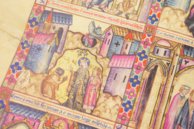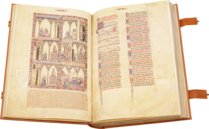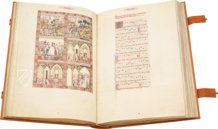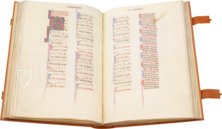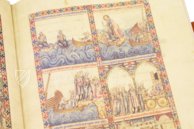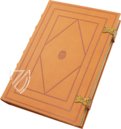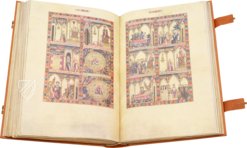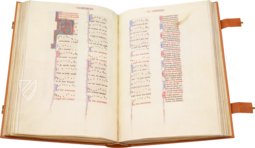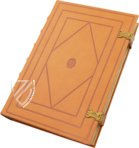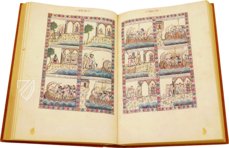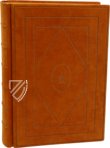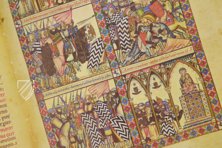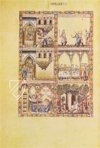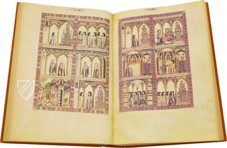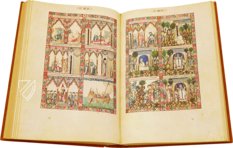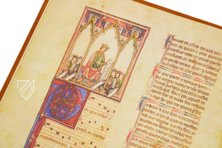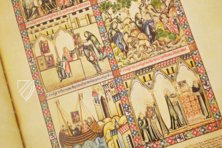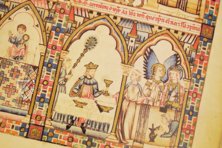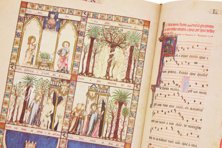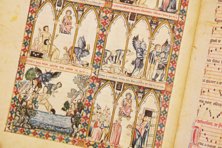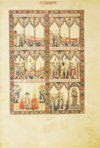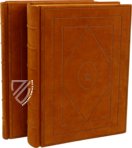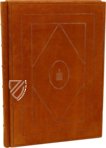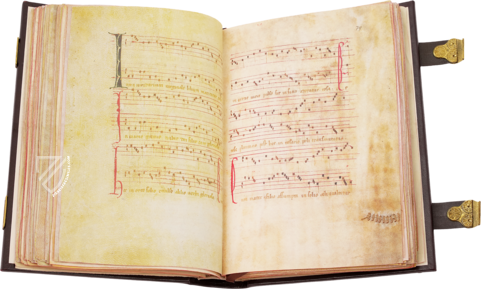Las Cantigas de Santa Maria - El Códice Rico
(7,000€ - 10,000€)
The so-called Rich Codex of Cantigas de Santa Maria is one of the most significant pieces of evidence of 13th century Spanish history. Alfonso X, King of Castile, commissioned a manuscript that brought poetry music, and imagery together in a unique conjunction. Songs praising the Virgin Mary, composed from various poets, stand at the center of the manuscript. These poems dedicated to Mary were illustrated in marvelous pictures, which offer a glimpse into the manuscript’s time of origin and which are considered to be important sources for the history of Castile. A truly historical, literary, and artistic work of art!
Las Cantigas de Santa Maria - El Códice Rico
The so-called Rich Codex of Cantigas de Santa Maria is one of the most significant pieces of evidence of 13th century Spanish history. Alfonso X, King of Castile, commissioned a manuscript that brought poetry music, and imagery together in a unique conjunction. Songs praising the Virgin Mary, composed from various poets, stand at the center of the manuscript. These poems dedicated to Mary were illustrated in marvelous pictures, which offer a glimpse into the manuscript’s time of origin and which are considered to be important sources for the history of Castile. A truly historical, literary, and artistic work of art!
A Royal Poet?
Alfonso X (1221–1284), called the Wise, was a significant Castilian king. He is presumed to be the patron of the manuscript of Cantigas de Santa Maria. This was an important project for the King himself, meant to impressively represent his land with its rich culture and history. Some researchers have gone so far as to suggest that Alfonso X himself composed some of the songs. One of the authors of the songs for the Virgin Mary was probably Airas Nunes. In the field of research, many of the songs are attributed to the 13th century Spanish poet and troubadour, who was active at the court of Sancho IV, the son of Alfonso X.
Over 1,000 Wonderful Miniatures
The Cantigas de Santa Maria contains 196 hymns in the Galician-Portuguese language. Their primary theme is the praise of the Virgin Mary, hence the name “Songs for the Virgin Mary”. Mary stands in the middle of the songs as the Mother of God, as a biblical figure, and as a participant in worldly scenes, e.g. holidays with a Marian connection. Each of the songs is illustrated with six or twelve miniatures, which incorporate references to the respective content. The miniatures enchant with their fine and gracile execution. Gothic architecture was often employed as a background. Wonderful imagery and fantastically vivid and realistic scenes unfold in marvelously adorned ornamental frames. A colorful text in black, blue, and red ink, the colors that also reign over the text, accompanies the image pages.
The Rich Codex
The 512-page manuscript measuring 50.2 x 35 cm from the famous El Escorial Library probably originated in the 1380’s, before the death of Alfonso X. It enchants with its unique and harmonious union of poetry, music, and imagery into a gorgeous synthesis of the arts. The Cantigas de Santa Maria is an exceptional piece due to its artistic adornment, but also because of its outstanding historical worth. The Cantigas de Santa Maria has been handed down in four codices in Madrid, Florence, and an additional copy in the El Escorial, respectively. The manuscript at hand, known as the codex rico – rich codex – noticeably stands out from among this group through its exceptionally impressive decoration.
Codicology
- Alternative Titles
- Códice Rico
Cantigas de Alfonso X El Sabio
Cantigas de Santa Maria - Codex Rico
Lieder für die heilige Maria, CSM - Size / Format
- 512 pages / 50.2 × 35.0 cm
- Origin
- Spain
- Date
- 13th century
- Style
- Genre
- Language
- Illustrations
- 1,257 richly detailed miniatures in colorfully ornamented frames, various large ornamental initials, and countless smaller fleuronnée initials
- Artist / School
- Airas Nunes (ca. 1230-93)
King Alphonso X of Castile (1221-1284), "the Wise"
Las Cantigas de Santa Maria - El Códice Rico
Prologue
Accompanied by a splendid zoomorphic initial with dragons, this miniature at the beginning of the manuscript shows King Alfonso X, who supposedly commissioned it. He is seated and flanked by scribes who sit on the ground while a group of tonsured men on the right examine a codex. Three musicians on the left play stringed instruments: two vielles, which are similar to modern violins but with somewhat longer and deeper bodies, and a citole, which is picked or strummed in the manner of a guitar.
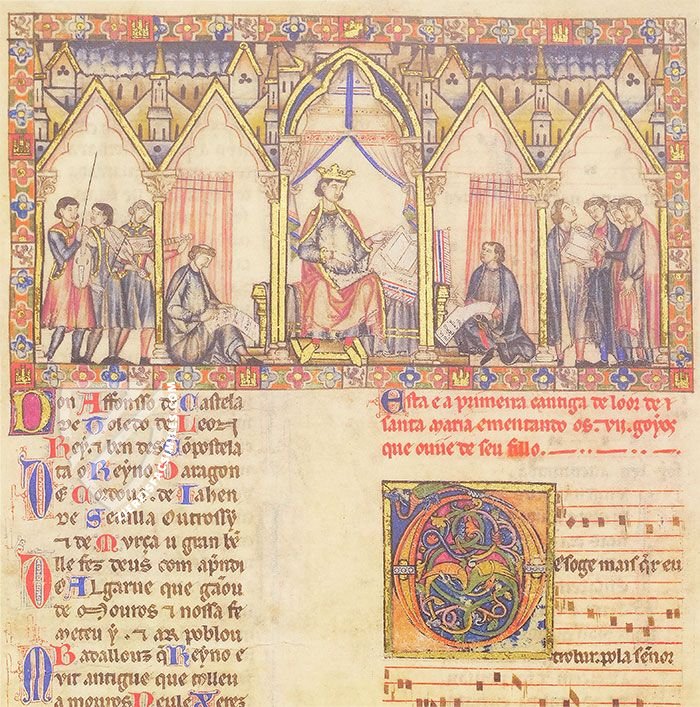
Las Cantigas de Santa Maria - El Códice Rico
The Siege of Constantinople (626)
During the 7th century, the ailing Byzantine Empire was saved by the aggressive campaigning of the Emperor Heraclius in the East and the successful defense of Constantinople in 626 against a combined force of Persians, Avars, and allied Slavs. When the siege was over, both the defenders and attackers agreed that the city was saved through divine intervention.
The badly outnumbered defenders of Constantinople were rallied by a daily procession along the Theodosian Walls that paraded an icon of the Virgin Mary. This series of miniatures shows the arrival of the besieging army, their construction of siege engines represented by a trebuchet, and the intervention of the Theotokos or “Mother of God” who appears in the sky above the city.
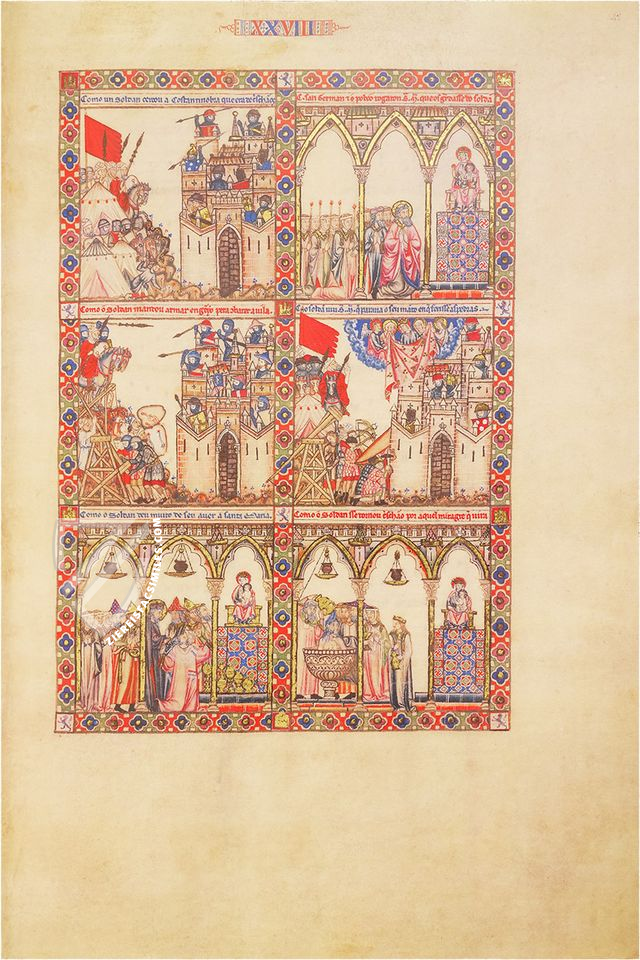
#1 Las Cantigas de Santa Maria, el Códice Rico
Languages: English, Portuguese, Spanish
(7,000€ - 10,000€)
#2 Cantigas de Santa María
Language: Spanish
(1,000€ - 3,000€)
- Treatises / Secular Books
- Apocalypses / Beatus
- Astronomy / Astrology
- Bestiaries
- Bibles / Gospels
- Chronicles / History / Law
- Geography / Maps
- Saints' Lives
- Islam / Oriental
- Judaism / Hebrew
- Single Leaf Collections
- Leonardo da Vinci
- Literature / Poetry
- Liturgical Manuscripts
- Medicine / Botany / Alchemy
- Music
- Mythology / Prophecies
- Psalters
- Other Religious Books
- Games / Hunting
- Private Devotion Books
- Other Genres
- Afghanistan
- Armenia
- Austria
- Belgium
- Colombia
- Croatia
- Cyprus
- Czech Republic
- Denmark
- Egypt
- Ethiopia
- France
- Germany
- Greece
- Hungary
- India
- Iran
- Iraq
- Israel
- Italy
- Japan
- Lebanon
- Luxembourg
- Mexico
- Morocco
- Netherlands
- Palestine
- Peru
- Poland
- Portugal
- Russia
- Serbia
- Spain
- Sri Lanka
- Sweden
- Switzerland
- Syria
- Turkey
- Ukraine
- United Kingdom
- United States
- Uzbekistan
- Aboca Museum
- Ajuntament de Valencia
- Akademie Verlag
- Akademische Druck- u. Verlagsanstalt (ADEVA)
- Aldo Ausilio Editore - Bottega d’Erasmo
- Alecto Historical Editions
- Alkuin Verlag
- Almqvist & Wiksell
- Amilcare Pizzi
- Andreas & Andreas Verlagsbuchhandlung
- Archa 90
- Archiv Verlag
- Archivi Edizioni
- Arnold Verlag
- ARS
- Ars Magna
- ArtCodex
- AyN Ediciones
- Azimuth Editions
- Badenia Verlag
- Bärenreiter-Verlag
- Belser Verlag
- Belser Verlag / WK Wertkontor
- Benziger Verlag
- Bernardinum Wydawnictwo
- BiblioGemma
- Biblioteca Apostolica Vaticana (Vaticanstadt, Vaticanstadt)
- Bibliotheca Palatina Faksimile Verlag
- Bibliotheca Rara
- Boydell & Brewer
- Bramante Edizioni
- Bredius Genootschap
- Brepols Publishers
- British Library
- C. Weckesser
- Caixa Catalunya
- Canesi
- CAPSA, Ars Scriptoria
- Caratzas Brothers, Publishers
- Carus Verlag
- Casamassima Libri
- Chavane Verlag
- Christian Brandstätter Verlag
- Circulo Cientifico
- Club Bibliófilo Versol
- Club du Livre
- CM Editores
- Collegium Graphicum
- Collezione Apocrifa Da Vinci
- Comissão Nacional para as Comemorações dos Descobrimentos Portugueses
- Coron Verlag
- Corvina
- CTHS
- D. S. Brewer
- Damon
- De Agostini/UTET
- De Nederlandsche Boekhandel
- De Schutter
- Deuschle & Stemmle
- Deutscher Verlag für Kunstwissenschaft
- DIAMM
- Droz
- E. Schreiber Graphische Kunstanstalten
- Ediciones Boreal
- Ediciones Grial
- Ediclube
- Edições Inapa
- Edilan
- Editalia
- Edition Deuschle
- Edition Georg Popp
- Edition Leipzig
- Edition Libri Illustri
- Editiones Reales Sitios S. L.
- Éditions de l'Oiseau Lyre
- Editions Medicina Rara
- Editorial Casariego
- Editorial Mintzoa
- Editrice Antenore
- Editrice Velar
- Edizioni Edison
- Egeria, S.L.
- Eikon Editores
- Electa
- Emery Walker Limited
- Enciclopèdia Catalana
- Eos-Verlag
- Ephesus Publishing
- Ernst Battenberg
- Eugrammia Press
- Extraordinary Editions
- Fackelverlag
- Facsimila Art & Edition
- Facsimile Editions Ltd.
- Facsimilia Art & Edition Ebert KG
- Faksimile Verlag
- Feuermann Verlag
- Folger Shakespeare Library
- Franco Cosimo Panini Editore
- Friedrich Wittig Verlag
- Fundación Hullera Vasco-Leonesa
- G. Braziller
- Gabriele Mazzotta Editore
- Gebr. Mann Verlag
- Gesellschaft für graphische Industrie
- Getty Research Institute
- Giovanni Domenico de Rossi
- Giunti Editore
- Graffiti
- Grafica European Center of Fine Arts
- Guido Pressler
- Guillermo Blazquez
- Gustav Kiepenheuer
- H. N. Abrams
- Harrassowitz
- Helikon
- Hendrickson Publishers
- Henning Oppermann
- Herder Verlag
- Hes & De Graaf Publishers
- Hoepli
- Holbein-Verlag
- Hortus Deliciarum
- Houghton Library
- Hugo Schmidt Verlag
- Idion Verlag
- Il Bulino, edizioni d'arte
- ILte
- Imago
- Insel Verlag
- Instituto Nacional de Antropología e Historia
- Istituto dell'Enciclopedia Italiana - Treccani
- Istituto Ellenico di Studi Bizantini e Postbizantini
- Istituto Geografico De Agostini
- Istituto Poligrafico e Zecca dello Stato
- Italarte Art Establishments
- J. Thorbecke
- Jan Thorbecke Verlag
- Johnson Reprint Corporation
- Josef Stocker
- Josef Stocker-Schmid
- Jugoslavija
- Karl W. Hiersemann
- Kasper Straube
- Kaydeda Ediciones
- Kindler Verlag / Coron Verlag
- Kodansha International Ltd.
- Konrad Kölbl Verlag
- Kurt Wolff Verlag
- La Liberia dello Stato
- La Linea Editrice
- La Meta Editore
- Lambert Schneider
- Landeskreditbank Baden-Württemberg
- Leo S. Olschki
- Les Incunables
- Library of Congress
- Libreria Musicale Italiana
- Lichtdruck
- Lito Immagine Editore
- Lumen Artis
- Lund Humphries
- M. Moleiro Editor
- Maison des Sciences de l'homme et de la société de Poitiers
- Manuscriptum
- Martinus Nijhoff
- Maruzen-Yushodo Co. Ltd.
- MASA
- McGraw-Hill
- Militos
- Millennium Liber
- Müller & Schindler
- Nahar and Steimatzky
- National Library of Wales
- Neri Pozza
- Nova Charta
- Oceanum Verlag
- Odeon
- Orbis Mediaevalis
- Orbis Pictus
- Österreichische Staatsdruckerei
- Oxford University Press
- Pageant Books
- Parzellers Buchverlag
- Patrimonio Ediciones
- Pattloch Verlag
- PIAF
- Pieper Verlag
- Plon-Nourrit et cie
- Prestel Verlag
- Princeton University Press
- Prisma Verlag
- Priuli & Verlucca, editori
- Pro Sport Verlag
- Propyläen Verlag
- Pytheas Books
- Quaternio Verlag Luzern
- Reales Sitios
- Recht-Verlag
- Reichert Verlag
- Reichsdruckerei
- Riehn & Reusch
- Roberto Vattori Editore
- Rosenkilde and Bagger
- Roxburghe Club
- Salerno Editrice
- Sarajevo Svjetlost
- Schöck ArtPrint Kft.
- Scolar Press
- Scrinium
- Scripta Maneant
- Scriptorium
- Siloé, arte y bibliofilia
- SISMEL - Edizioni del Galluzzo
- Sociedad Mexicana de Antropología
- Société des Bibliophiles & Iconophiles de Belgique
- Soncin Publishing
- Sorli Ediciones
- Stainer and Bell
- Studer
- Styria Verlag
- Sumptibus Pragopress
- Szegedi Tudomànyegyetem
- Taberna Libraria
- Tarshish Books
- Taschen
- Tempus Libri
- Testimonio Compañía Editorial
- Thames and Hudson
- The Clear Vue Publishing Partnership Limited
- The Facsimile Codex
- The Folio Society
- The Marquess of Normanby
- The Richard III and Yorkist History Trust
- Tip.Le.Co
- TouchArt
- TREC Publishing House
- TRI Publishing Co.
- Trident Editore
- Typis Regiae Officinae Polygraphicae
- Union Verlag Berlin
- Universidad de Granada
- University of California Press
- University of Chicago Press
- Urs Graf
- Vallecchi
- Van Wijnen
- VCH, Acta Humaniora
- VDI Verlag
- VEB Deutscher Verlag für Musik
- Verlag Anton Pustet / Andreas Verlag
- Verlag Bibliophile Drucke Josef Stocker
- Verlag der Münchner Drucke
- Verlag für Regionalgeschichte
- Verlag Styria
- Vicent Garcia Editores
- W. Turnowsky
- Waanders Printers
- Wiener Mechitharisten-Congregation (Wien, Österreich)
- Wissenschaftliche Buchgesellschaft
- Wydawnictwo Dolnoslaskie
- Xuntanza Editorial
- Zakład Narodowy
- Zollikofer AG






